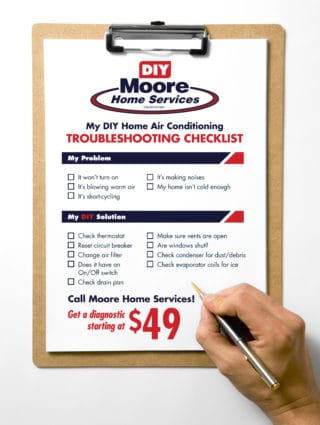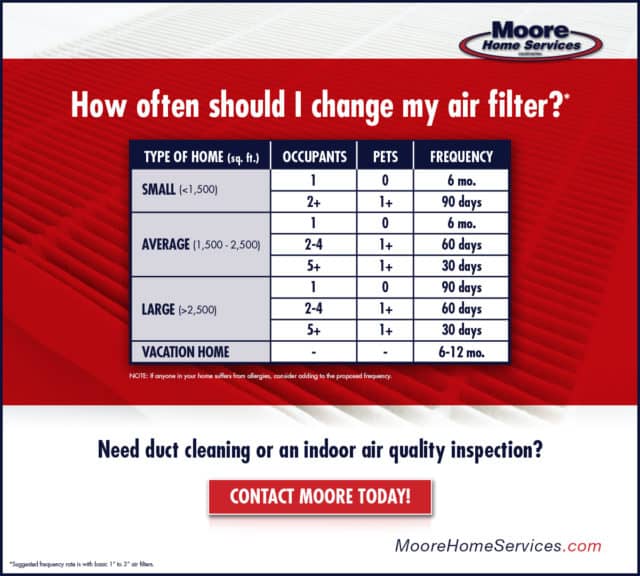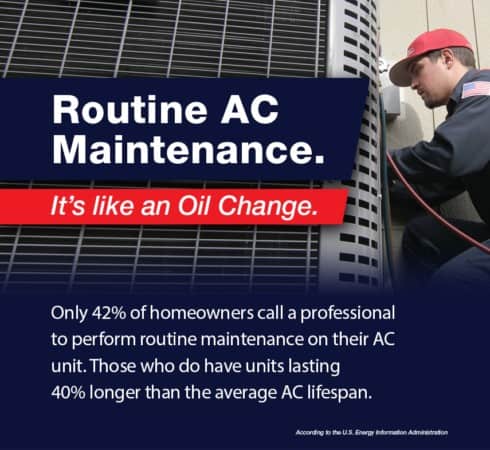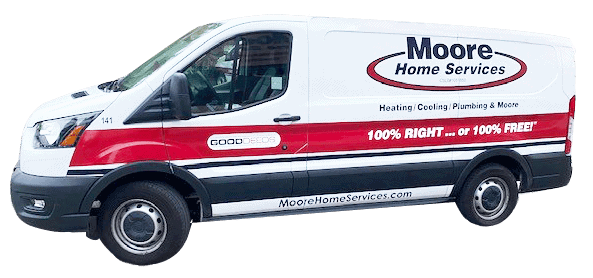DIY Repair Your Central Air Conditioner
What’s wrong with your central air conditioner unit? The path to cleaner, cooler air in a more efficient household may be shorter than you think – and you may be able to walk it on your own, without assistance and the cost that comes with it. Often times, you can DIY repair your air conditioner unit.
There’s nothing worse than being uncomfortable in the heat. That goes double if it’s your own home. Your home should be the one safe haven you escape the scorching rays of the sun to sit on a cloud of cool air (your couch), accompanied perhaps by the steady breeze of your fan.
A famous mythical cartoon character action figure once said “Knowing Is Half The Battle.” (GI Joe, anyone?). That’s true — there are a myriad of issues that could go wrong with your unit. But if you can’t even answer what type of unit you have, how will you fix it?
What Type of AC Unit am I Troubleshooting?

The two most common types of air conditioning units are split units and packaged units. They can be briefly described by these simple differences:
Split units – these feature two parts – the condenser on the outside of your home and the evaporator coils somewhere in the inside of your home.
Packaged unit – this is a condenser and evaporator coil that have been built together. These are typically placed in the attic of a home.
What are some of the big differences? According to Modernize, “A major plus to a split system is its ability to be an efficient addition to your home. This not only saves money each month, it’s a good selling point should you put your home on the market to the future.”
However, labor costs are higher for installation of split units, due to both indoor and outdoor components needing work.
Packaged units save space and time on installation, but are typically less efficient. Also, weather can play a factor, as the electrical components of a package system are outside the home. Some things to consider when choosing:
- Your budget
- Square footage of your home
- Climate
- What type/how much duct work you need
There are other types of AC units, but these two are the ones we will be focusing. If you have a wall unit, we have a section on this too. Many of these fixes are practical, sensible reminders!
Use this as your guide and DIY checklist to ensure your AC is living its best life each and every day, so you can live yours!
My AC Won’t Turn On
This seems to usually happen at the worst time – whether it’s the first hot day in the spring or on the hottest day of the year. However, it’s also the most easily noticeable and you shouldn’t panic. There are steps you can take to ensure you can start your unit back up without having to pay a service professional.
DIY Fixes For When Your AC Won’t Turn On
1. Check the thermostat and circuit breaker.
Have you ever spent ten minutes looking for your car keys when they are in your coat pocket the whole time? A thermostat or circuit breaker issue is the equivalent of this for an AC breakdown. It’s that simple. Your thermostat could be switched to the “heat” control or is set too high to kick on. If your thermostat uses batteries, it could be simply in need of a change. You should also reset your circuit breaker.
Thermostat issues can go beyond simple issues – for example, the wiring could be a problem and it may need replaced. Also, if your circuit breaker has tripped, do not attempt to reset it more than once.
2. Check if your AC has a switch
Some makes and models of home air conditioning units have an ON/OFF switch that has been flipped. Did you flip it when winter rolled around and then forgot about it? This is usually in the form of a light switch.
3. Check your air filter.
Clogged air filters can cause a number of issues with airflow within your system. Make sure you change your air filters every three months.
You should be changing your air filter at least once every three months, depending on where you live (and who you live with). Airflow blockage is the root of many system issues. Likewise, it is bad for indoor air quality, so don’t forget to take care of this!
4. Check your drain pan
If you have a split unit, your drain pan will be located where your evaporator coil is inside. If you have a packaged unit, it is likely in your attic. Some issues with a drain pan:
- It is full
- It is rusted through
- The drain is clogged
Professional fixes for your AC Unit Not Turning On

If your AC is not turning on, it could mean a number of issues that may require:
- Blown fuse replacement
- Capacitor replacement
- Circuit board replacement
- Compressor replacement
- Condensate pump replacement
- Evaporator coil replacement
- Fan motor replacement
- Refrigerant leak diagnostic
- Thermostat replacement
My AC Is Short-Cycling
When your AC is short-cycling, there is something turning off the compressor before it can run through a full cooling cycle. This can become a major issue over time, because it decreases the efficiency of your unit and drives your energy bills through the roof.
DIY Fixes for Your AC Cycling Issues
1. Frozen Evaporator Coils
If your evaporator coils are frozen, this is directly related to airflow, and might be as simple as changing your air filter. But that isn’t always the case.
Your evaporator coils are the mechanism that cools air before it enters your home. If they are frozen, they’re not getting enough warmth from outsize airflow. Another possible DIY fix for this is your vents are closed. Check each vent in your home and make sure they are open.
2. Properly Sized Unit Not Dehumidifying Home
Its possible you have too much humidity in your home caused by another issue entirely, such a as a leak or open windows. Moore Home Services will always check for these issues upon inspection.
Professional Fixes for Your Cycling Issues
1. Your Unit is Oversized
It might sound nice to have your home cooled as quickly as possible, but that’s not what you actually want to happen. If your thermostat is shutting off the system before the humid air comes across the cooling coil to dehumidify, this can cause a larger issue. Unfortunately, your only options are to replace the unit or add duct to an expanded space in your home, such as your garage or basement.
2. Leaking Refrigerant
Many homeowners think you can add refrigerant to a home air conditioning unit like you can with your car, and the issue is fixed. But this is not the case. If an HVAC contractor is telling you otherwise, it is a scam. Talk to Moore HVAC about this problem, we can give you the best recommendation based on the size and SEER rating of your unit. Want to read more about SEER? Scroll below.
3. Electrical Malfunction
Wiring and control boards can become worn out over time. If you think your unit has an electrical issues, do not try to fix it yourself.
My AC System Is Not Blowing Cold Air
If your system is not blowing cold air, there can be the usual suspects at hand, including:
- Power outlet problems
- Thermostat issues (turn the dial down)
- Clogged air filters
- Ice buildup on your evaporator coils
DIY Fixes for Your AC System Not Blowing Cold Air
1. Parts In/Around Your Condenser Are Dirty
Your condenser is a unit that is the sum of many other parts, including:
- Compressor
- Circuit board
- Condenser coil
- Tubes
- Fans
- Motor
The condenser unit can get dirty over time as plants, grass and brush can grow around and cover the unit. This can cause your unit to work ineffectively.
Professional Fixes for Your AC System Not Blowing Cold Air
1. Low Refrigerant
We’ve discussed low refrigerant before, but again, its worth mentioning. Your AC unit is always made and shipped with the amount of refrigerant it should need for a full lifespan. If it is escaping, you can have a professional re-fill, but it runs on a closed circuit, meaning that your issue will simply happen again.
Signs of a refrigerant leak include warm air coming from your vents, higher than usual energy bills, ice on your refrigerant lines, a frozen evaporator coil or hissing/bubbling sounds coming from your refrigerant lines.
What kind of refrigerant does my AC use? It depends. If your unit was manufactured before 2010, it uses HCFC-22. If it was made after, it uses R-22 (Freon)
2. Leaks in Your Condenser
Leaks can pop up through faulty seals or breaks in the tubes inside your condenser. Be careful of any contractor that only wants to replace the condenser without making a change to your indoor coil if you have a split unit. With an old indoor coil, you unit is no more efficient than the old one.
Moore Home Services always will do a technical audit of your entire system, not just your compressor. This way, you can make an informed decision
Diagnostics of a bad compressor start with one thing – noise. Just listen. If you hear a sound such as a clicking, rumbling, or rattle If it struggles to turn on (hard start) this could be a sign of impending failure.
A compressor is responsible for pressurizing the refrigerant and pushing it into the condenser, helping to remove heat.
3. Bad Relay Switch
If you hear a rattling noise when you first turn on your AC unit, this could be your relay switch. The relay switch is an integral part of your system, as it is the electrical switch that starts your compressor.
4. Control Board Malfunction
The control board is what communicates all of the parts with the condenser. It can wear out over time and needs to be replaced.
5. Worn Out Expansion Valve
The expansion valve is a critical part responsible for controlling the pressure of cold gas before it enters your home. You can detect signs of this by discovering frost on the evaporator, or if your compressor is always running.
My Energy Bills Are Higher Than Usual!

Before you call, there’s some things you should double check some things.
- Does your home get a lot of sunlight – and if so, where is it getting it from? Sometimes, a window that sits in direct sunlight with no shade can make your air conditioning unit work harder.
- Are your windows energy efficient? Most associate drafty windows with cold weather, but the same holds true homes that have cracks in or around their seals in the summertime.
- If we have to say it once, it’s a thousand times. Change your air filter. Indoor air quality is important!
If your energy bills are abnormally high, you might have an issue with your air conditioning unit. Make sure you change your air filter to ensure the unit is operating at maximum efficiency. A dirty air filter can cause your AC to work harder, for longer. Likewise, if your unit is more than 10 years old, its SEER rating may not be up to par, costing you more money to operate per month than a new unit would cost you over the next few years.
What is SEER Rating?
SEER (Seasonal Energy Efficiency Ratio) is determined by the measure of an AC unit’s BTU, divided by its total electric energy output. The higher the SEER, the more expensive and efficient the unit.
Higher SEER units typically come with better features. Notably, units with higher SEER come with variable speed motors – this can be helpful to the comfort and feel of the home, because the unit does not just need to rotate between blasting cold air or being off, keeping the home’s temperature more consistent.
Getting a unit with the highest possible SEER is not always the correct choice. Sometimes homeowners will spend more on a much higher SEER unit when they won’t get the lifetime value in energy savings. Want to get a rough idea of what a new unit could do for you? Use our energy savings calculator!
Air Conditioning Maintenance Plans
Did you know that only 42% of homeowners call a professional to perform routine maintenance on their AC unit? Those who do have air conditioners that last 40% longer than the average AC lifespan, according to the U.S. Information Administration.
Moore Home Services offers annual maintenance programs, including our Gold Club Program, so you can ensure your unit will last up to the standard of its projected shelf life.
Troubleshooting My AC Wall Unit
If your wall unit is malfunctioning, here are a few steps you can take to make sure you need a diagnostic service call:
- Check your circuit breaker for blown fuses
- Make sure your wall unit is correctly plugged into a nearby outlet
- Make sure your remote control has batteries
- If your unit has a quiet setting, disable it.
- Change the air filter
- Remove the front paneling and vacuum dust out of the inside
- Inspect any outside air intakes to make sure there’s no debris covering them
Looking for more help? Check out our DIY widget for all of your AC and furnace issues. It’s located on any of our service pages!

